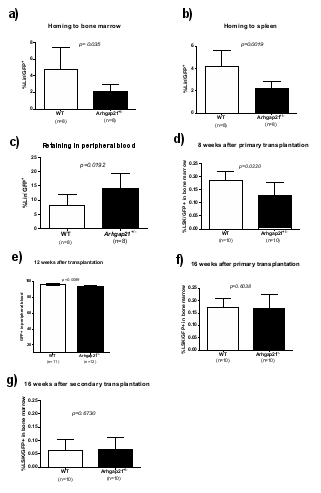Abstract
The microenvironment of the bone marrow (BM) is essential for retention and migration of hematopoietic progenitor cells. ARHGAP21 is a negative regulator of RhoGTPAses, involved in cellular migration and adhesion, however the role of ARHGAP21 in hematopoiesis is unknown.
In order to investigate whether downregulation of Arhgap21 in microenvironment modulates bone marrow homing and reconstitution, we generated Arhgap21+/-mice using Embryonic Stem cell containing a vector insertion in Arhgap21 gene obtained from GeneTrap consortium and we then performed homing and bone marrow reconstitution assays.
Subletally irradiated (9.5Gy) Arhgap21+/- and wild type (WT) mice received 1 x 106 BM GFP+cells by IV injection. For homing assay, 19 hours after the transplant, Lin-GFP+ cells were analyzed by flow cytometry. In reconstitution and self-renew assays, the GFP+ cell percentage in peripheral blood were analyzed 4, 8, 12 and 16 weeks after transplantation. Hematopoietic stem cells [GFP+Lin-Sca+c-Kit+ (LSK)] were counted after 8 and 16 weeks in bone marrow after primary transplant and 16 weeks after secondary transplant.
The percentage of Lin-GFP+ hematopoietic progenitor cells that homed to Arhgap21+/-recipient (mean± SD) (2.07 ± 0.85) bone marrow was lower than those that homed to the WT recipient (4.76 ± 2.60); p=0.03. In addition, we observed a reduction (WT: 4.22 ±1.39; Arhgap21+/-: 2.17 ± 0.69; p=0.001) of Lin- GFP+ cells in Arhgap21+/-receptor spleen together with an increase of Lin- GFP+ population in Arhgap21+/-receptor peripheral blood (WT: 8.07 ± 3.85; Arhgap21+/-: 14.07 ±5.20; p=0.01), suggesting that hematopoietic progenitor cells which inefficiently homed to Arhgap21+/-bone marrow and spleen were retained in the blood stream.
In bone marrow reconstitution assay, Arhgap21+/-receptor presented reduced LSK GFP+ cells after 8 weeks (WT: 0.19 ±0.03; Arhgap21+/-0.12±0.05; p=0.02) though not after 16 weeks from primary and secondary transplantation. The reduced LSK percentage after short term reconstitution was reflected in the lower GFP+ cells in peripheral blood 12 weeks after transplantation (WT: 96.2 ±1.1; Arhgap21+/-94.3±1.6; p=0.008). No difference was observed in secondary transplantation, indicating that Arhgap21reduction in microenvironment does not affect normal hematopoietic stem cell self-renewal.
The knowledge of the niche process in regulation of hematopoiesis and their components helps to better understand the disordered niche function and gives rise to the prospect of improving regeneration after injury or hematopoietic stem and progenitor cell transplantation.
In previous studies, the majority of vascular niche cells were affected after sublethal irradiation, however osteoblasts and mesenchymal stem cells were maintained (Massimo Dominici et al.; Blood; 2009.). RhoGTPase RhoA, which is inactivated by ARHGAP21 (Lazarini et al.; Biochim Biophys acta; 2013), has been described to be crucial for osteoblasts and mesenchymal stem cell support of hematopoiesis (Raman et al.; Leukemia; 2013). Taken together, these results suggest that Arhgap21 expression in bone marrow niche is essential for homing and short term reconstitution support. Moreover, this is the first study to investigate the role of Arhgap21 in bone marrow niche.
Reduced homing and short term reconstitution in Arhgap21+/- recipients. Bone marrow cells from GFP+ mice were injected into wild-type and Arhgap21+/- sublethally irradiated mice. 19 hours after the transplant, a decreased homing was observed to both bone marrow (a) and spleen (b) together with an increase of retained peripheral blood (c) Lin-GFP+ cells. In serial bone marrow transplantation, Arhgap21+/- presented reduced bone marrow LSK GFP+ cells 8 weeks (d) and peripheral blood GFP+ cells 12 weeks (e) after primary transplantation, though not 16 weeks after primary (f) and 16 weeks after secondary (g) transplantations. The result is expressed by means ±SD of 2 independent experiments.
Reduced homing and short term reconstitution in Arhgap21+/- recipients. Bone marrow cells from GFP+ mice were injected into wild-type and Arhgap21+/- sublethally irradiated mice. 19 hours after the transplant, a decreased homing was observed to both bone marrow (a) and spleen (b) together with an increase of retained peripheral blood (c) Lin-GFP+ cells. In serial bone marrow transplantation, Arhgap21+/- presented reduced bone marrow LSK GFP+ cells 8 weeks (d) and peripheral blood GFP+ cells 12 weeks (e) after primary transplantation, though not 16 weeks after primary (f) and 16 weeks after secondary (g) transplantations. The result is expressed by means ±SD of 2 independent experiments.
No relevant conflicts of interest to declare.
Author notes
Asterisk with author names denotes non-ASH members.


This feature is available to Subscribers Only
Sign In or Create an Account Close Modal